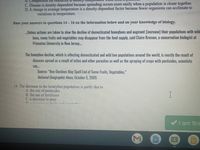
Biology Today and Tomorrow without Physiology (MindTap Course List)
5th Edition
ISBN: 9781305117396
Author: Cecie Starr, Christine Evers, Lisa Starr
Publisher: Cengage Learning
expand_more
expand_more
format_list_bulleted
Question

Transcribed Image Text:**Question 17:**
A fruit fly that has a short life span, produces many offspring, and spends little energy raising their young can be classified into which reproductive strategy?
A. *r*-strategist
B. a carrying-capacity strategist
C. *k*-strategist
D. a logistic strategist
**Explanation:** This question relates to ecological reproductive strategies. Organisms classified as *r*-strategists typically have short lifespans, produce many offspring, and invest minimal energy in raising them. *K*-strategists usually have longer lifespans, produce fewer offspring, and invest more energy in parental care.

Transcribed Image Text:### Honeybee Population Decline
**Context:**
The decline in both domesticated and wild bee populations is a critical issue affecting ecosystems and agriculture globally. According to scientists, the main factors contributing to this decline include diseases spread by mites and other parasites, as well as the extensive use of pesticides on crops.
**Source:**
“Bee Declines May Spell End of Some Fruits, Vegetables,” *National Geographic News*, October 5, 2005.
**Discussion:**
Conservation biologist Claire Kremen from Princeton University emphasizes the importance of taking action to slow the decline of domesticated honeybees and support wild bee populations. Without intervention, the disappearance of bees could lead to a significant reduction in the availability of many fruits and vegetables.
### Key Questions:
**14. What is partly responsible for the decrease in the honeybee population?**
A. The use of pesticides
B. The use of fertilizers
C. A decrease in prey
D. A decrease in fruits and vegetables
**Answer:** A. The use of pesticides
**Explanation:**
The use of pesticides is identified as a key factor in the decline of honeybee populations. Pesticides can have harmful effects on bees, contributing to colony collapse and population decline.
Expert Solution
This question has been solved!
Explore an expertly crafted, step-by-step solution for a thorough understanding of key concepts.
This is a popular solution
Trending nowThis is a popular solution!
Step by stepSolved in 3 steps

Knowledge Booster
Similar questions
- Houseflies develop through a series of programmed stages from egg, to larva, to pupa, to flying adult. This series of stages is called: a. artificial selection. b. respiration. c. homeostasis. d. a life cycle. e. metabolism.arrow_forwardSCIENCE, TECHNOLOGY, AND SOCIETY Imagine that you are a graduate student working with university scientists on the effects on sea turtles of the 2010 oil spill in the Gulf of Mexico. What technologies might you employ to collect data for your research? Knowing that the turtles life cycle includes laying eggs on beaches, how would you involve local communities in your research?arrow_forwardWhich type of country has the greatest proportion of young individuals? a. economically developed b. economically underdeveloped c. countries with zero population growth d. countries in Europearrow_forward
- Figure 19.6 If the major food source of seals declines due to pollution or overfishing, which of the following would likely occur? a. The carrying capacity of seals would decrease, as would the seal population. b. The carrying capacity of seals would decrease, but the seal population would remain the same. c. The number of seal deaths would increase, but the number of births would also increase, so the population size would remain the same. d. The carrying capacity of seals would remain the same, but the population of seals would decrease.arrow_forwardA feeding relationship that proceeds from algae to a fish, then to a fisherman, and then to a shark is _____. a. a food chain b. a food web c. a and barrow_forwardA forest fire is an example of ________ regulation. a. density-dependent b. density-independent c. r-selected d. K-selectedarrow_forward
- Lizards that eat flies they capture on the ground and birds that eat flies they catch in the air are engaged in _______ competition. a. exploitative b. interferencearrow_forwardFigure 1.15 Example of error bars in a graph. This graph was adapted from the peacock butterfly research described in Section 1.5. The researchers recorded the number of times each butterfly flicked its wings in response to an attack by a bird. The squares represent average frequency of wing flicking for each sample set of butterflies. The error bars that extend above and below the dots indicate the range of valuesthe sampling error. Figure It Out: What was the fastest rate at which a butterfly with no spots or sound flicked its wings?arrow_forwardThe type of place where a species typically lives is called its _______. a. niche c. community b. habitat d. populationarrow_forward
- Which of the following is not a way that humans have increased the carrying capacity of the environment? a. agriculture b. using large amounts of natural resources c. domestication of animals d. use of languagearrow_forwardDiscuss Concepts Many city-dwellers have noted that the density of cockroaches in apartment kitchens appears to vary with the habits of the occupants: people who wrap food carefully and clean their kitchen frequently tend to have fewer arthropod roommates than those who leave food on kitchen counters and clean less often. Interpret these observations from the viewpoint of a population ecologist.arrow_forwardA forest fire is an example of regulation. density-dependent density-independent r-selected K-selectedarrow_forward
arrow_back_ios
SEE MORE QUESTIONS
arrow_forward_ios
Recommended textbooks for you
 Biology Today and Tomorrow without Physiology (Mi...BiologyISBN:9781305117396Author:Cecie Starr, Christine Evers, Lisa StarrPublisher:Cengage Learning
Biology Today and Tomorrow without Physiology (Mi...BiologyISBN:9781305117396Author:Cecie Starr, Christine Evers, Lisa StarrPublisher:Cengage Learning
 Biology: The Dynamic Science (MindTap Course List)BiologyISBN:9781305389892Author:Peter J. Russell, Paul E. Hertz, Beverly McMillanPublisher:Cengage Learning
Biology: The Dynamic Science (MindTap Course List)BiologyISBN:9781305389892Author:Peter J. Russell, Paul E. Hertz, Beverly McMillanPublisher:Cengage Learning Biology (MindTap Course List)BiologyISBN:9781337392938Author:Eldra Solomon, Charles Martin, Diana W. Martin, Linda R. BergPublisher:Cengage Learning
Biology (MindTap Course List)BiologyISBN:9781337392938Author:Eldra Solomon, Charles Martin, Diana W. Martin, Linda R. BergPublisher:Cengage Learning Concepts of BiologyBiologyISBN:9781938168116Author:Samantha Fowler, Rebecca Roush, James WisePublisher:OpenStax CollegeEssentials Health Info Management Principles/Prac...Health & NutritionISBN:9780357191651Author:BowiePublisher:Cengage
Concepts of BiologyBiologyISBN:9781938168116Author:Samantha Fowler, Rebecca Roush, James WisePublisher:OpenStax CollegeEssentials Health Info Management Principles/Prac...Health & NutritionISBN:9780357191651Author:BowiePublisher:Cengage

Biology Today and Tomorrow without Physiology (Mi...
Biology
ISBN:9781305117396
Author:Cecie Starr, Christine Evers, Lisa Starr
Publisher:Cengage Learning


Biology: The Dynamic Science (MindTap Course List)
Biology
ISBN:9781305389892
Author:Peter J. Russell, Paul E. Hertz, Beverly McMillan
Publisher:Cengage Learning

Biology (MindTap Course List)
Biology
ISBN:9781337392938
Author:Eldra Solomon, Charles Martin, Diana W. Martin, Linda R. Berg
Publisher:Cengage Learning

Concepts of Biology
Biology
ISBN:9781938168116
Author:Samantha Fowler, Rebecca Roush, James Wise
Publisher:OpenStax College

Essentials Health Info Management Principles/Prac...
Health & Nutrition
ISBN:9780357191651
Author:Bowie
Publisher:Cengage